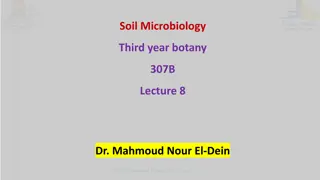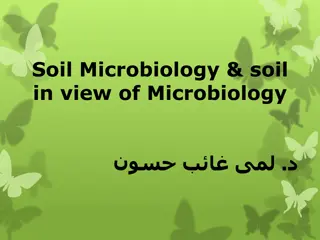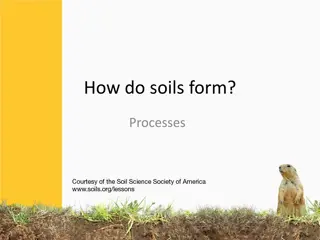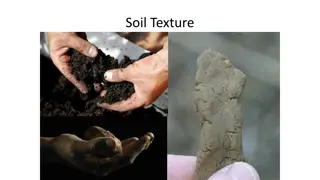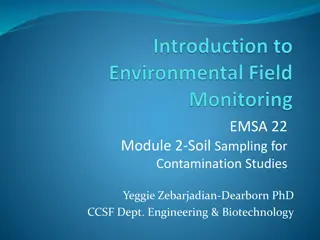Understanding Soil Composition and Importance
Explore the world of soil and its significance as a natural resource by discovering its composition and how it affects plant growth. Learn about the main ingredients of soil, its permeability, and the role of water, air, and organic matter. Gain insights into how soil supports plant life through leaching, plant litter, and the circulation of nutrients and air. Discover the impact of local soil composition on vegetation and explore different soil types.
Download Presentation

Please find below an Image/Link to download the presentation.
The content on the website is provided AS IS for your information and personal use only. It may not be sold, licensed, or shared on other websites without obtaining consent from the author. Download presentation by click this link. If you encounter any issues during the download, it is possible that the publisher has removed the file from their server.
E N D
Presentation Transcript
17 Soils Soils 17
17 17.0 Soils Soils Learning Intentions You will be able to: Explain what soil is. Understand what soil is made of. Explain how leaching and plant litter impact soil. Discuss four different types of soils. Study soil in your local area in relation to its composition and vegetation.
17 17.1 What is Soil? Soils Soil is the thin, uppermost layer of the earth. Soil is an essential natural resource. As well as providing us with food, soil is used for building, farming and much more.
17 17.1 What is Soil? Soils The Composition of Soil Soil is composed of five main ingredients. These ingredients work together to make the soil fertile.
17 17.1 What is Soil? Soils The Composition of Soil Mineral particles of sand, silt and clay, which vary in size, with clay being the smallest and sand the largest, make up most of the soil. 1
17 17.1 What is Soil? Soils The Composition of Soil The composition of a soil can affect the ability of water to flow through the soil. This is referred to as a soil s permeability. 1
17 17.1 What is Soil? Soils The Composition of Soil Water binds the soil together. It also dissolves any minerals and nutrients in the soils, so plants can soak them up in liquid form through their roots. 2
17 17.1 What is Soil? Soils The Composition of Soil Air is found in the pores (spaces) between the soil particles. It provides the necessary oxygen and nitrogen for plants, and oxygen for the living organisms found in soil. 3
17 17.1 What is Soil? Soils The Composition of Soil Organic matter is made of anything living, such as earthworms and beetles, as well as micro-organisms found in the soil. 4
17 17.1 What is Soil? Soils The Composition of Soil As worms move through the soil, they help air and water to circulate through it. Plant remains, such as leaves and twigs, turn into humus when they decay in the soil. 4
17 17.2 How Soil is Formed Soils Climate, time and human activity all play a key role in the formation of soil. Climate Provides frost, water, etc. to weather and erode rock Influences vegetation and living organisms Provides water Organisms change plant litter into humus Forms mineral particles All mix to form soil Soil Time Human activity Improves soil by fertilising, etc Damages soil by overuse, etc. Soil can take a long time to form
17 17.3 Soil Profiles Soils A soil profile is a vertical section of soil from its surface downwards. Soils have layers called horizons. Each layer is different from the one above and below it. A typical soil profile
17 17.3 Soil Profiles Soils 1 A horizon Sometimes called the topsoil, it is the top and most fertile layer of soil (closest to the surface), usually dark in colour because it contains the most humus and plant litter. A typical soil profile
17 17.3 Soil Profiles Soils 2 B horizon The subsoil. It is found just below the topsoil, has less humus and is lighter in colour than the topsoil. It may contain more stones than the topsoil as it is closer to the bedrock (C horizon). A typical soil profile
17 17.3 Soil Profiles Soils 3 C horizon It can be called the bedrock. It is a mixture of solid rock at its base and smaller rock pieces at its top. A typical soil profile
17 17.3 Soil Profiles Soils Two Impacts on Soil Formation 1 Leaching Leaching occurs when there is a high amount of rainfall. The water percolates (soaks) down through the soil and washes important minerals and nutrients down into the B horizon. It deprives plants of important nutrients and minerals when it washes them out of reach of their roots. It creates a hardpan when iron oxide minerals are washed from topsoil particles. Leaching
17 17.3 Soil Profiles Soils Two Impacts on Soil Formation 2 The Breakdown of Plant Litter Plant litter are broken down by insects and micro-organisms into humus, the black, jelly-like substance that contributes to soil fertility. Oxygen is needed to assist in the breakdown of plant litter into humus, because its presence in the soil helps keep organisms alive. The process of plant litter changing into humus is called humification.
17 17.4 Ireland s Soil Types Soils The amount of humus present in soil and the movement of water through soil combine to create many different types of soil. There are four types of soil in Ireland: Brown soils Podzols Gley soils Peaty soils
17 17.4 Ireland s Soil Types Soils Brown soil Ireland s most common soil type. Brown in colour. Found in areas where rainfall is limited, such as the midlands. Also found mainly in areas of deciduous forest. Very fertile and excellent for farming.
17 17.4 Ireland s Soil Types Soils Podzol soil Found in highland areas of Ireland where more rainfall occurs. Grey in colour due to hardpan. Found in coniferous forested areas. There is little plant litter on the forest floor to turn into humus. As a result, the soils are less fertile.
17 17.4 Ireland s Soil Types Soils Gley soil It forms on areas of rolling lowland or gently-sloping hills. Blue-grey in colour. It is very thin (not deep) and floods easily during rainfall, becoming waterlogged. Therefore, it is not very fertile.
17 17.4 Ireland s Soil Types Soils Peaty soil Also called bogland . It takes thousands of years to form. Dark in colour and can be heavily waterlogged. Therefore, it is not very fertile.
17 Soils 13.2 Forecasting the Weather My Geography Moment: The Soil in my Locality Results Tables Task 1: Examine the vegetation of your three chosen sites
17 Soils Task 2: Examine the texture of the three soil samples
17 Soils Task 3: Examine the humus content of one soil sample This is a sample results table that can be adapted to suit your own task details. Measurements Weight of soil sample used in experiment: 80 grams Weight of humus content extracted following completion of experiment: 6 grams Convert to a percentage: 6/80 x 100/1 = 7.5% Conclusions Breakdown of soil shows 7.5% humus content Fertile soil: Soil with a higher percentage of humus content Less fertile soil: Soil with less than 5% humus *Note: Results from Task 1: Examine the vegetation of your three chosen sites can also indicate humus content.
17 Soils Task 3: Examine the humus content of one soil sample This is a sample results table that can be adapted to suit your own task details. Identifying Soil Profiles from Humus Content Brown soil: Rich in humus content due to presence of vegetation; humus content gives this soil its brown colour. Podzol soil: Has very little humus content due to such characteristics as leaching and the presence of hardpan. Gley soil: Develops in areas prone to flooding (mountains); little or no humus content as a result. Peaty soil: Develops in upland areas and bogland areas, also prone to flooding; little or no humus content.
17 Soils Task 4: Measure the moisture and air content of one soil sample This is a sample results table that can be adapted to suit your own task details. Measurements Weight of soil used in experiment: 10 grams Weight of soil following experiment: 6.5 grams % air and water in soil: Convert weight loss to a percentage = 3.5/10 x 100 = 35% Conclusions Weight loss can be attributed to loss of air and soil due to heating. Air and water are essential for any plant and animal life to survive on or in soil. If soil has less than 25% air and 25% water, this can affect fertility.
17 Soils Task 4: Measure the moisture and air content of one soil sample This is a sample results table that can be adapted to suit your own task details. Identifying Soil Profiles from Moisture and Air Content Brown soil: High air content; high water permeability; relatively fertile. Podzol soil: Low air content (leacing causing hardpan); high water permeability; low fertility. Gley soil: Low air content; low water permeability (water table usually present); low fertility. Peaty soil: Low air content; low water permeability; low fertility.
17 Soils Task 5: Measure the permeability of one soil sample Amount of water that goes through the soil (ml) Length of time (seconds/mins) Identifying Soil Profiles from Soil Permeability Brown soil: Generally has good soil structure with adequate space for air and water; water would flow through quite easily; good fertility. Podzol soil: Water will also flow through this type of soil quite easily; however, poor fertility due to leaching and presence of hardpan. Gley soil: May have a poor soil structure. These soils may be sticky and hard to farm, as water does not flow through them easily, which can result in flooding. Peaty soil: Can often be saturated; this is because peat is good at retaining water, which can cause peat soils to flood; permeability is poor; fertility is poor.
17 Soils Video: Soil Profiles







